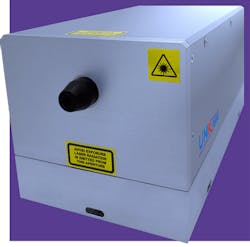
The Duetto 349 from UniKLasers Limited (Edinburgh, Scotland) is a single-frequency diode-pumped solid-state (DPSS) continuous-wave (CW) device that emits at 349 nm with a 50 mW output, reportedly making it the world’s first laser to operate with single frequency at 349 nm. This laser can be used across a wide range of scientific research and industrial engineering processes in applications where the laser system provides CW laser energy to further enhance engineering precision.
Current UV CW laser solutions for these applications are large, hindering integration into existing, established measurement systems where lasers with a small footprint, low ongoing maintenance requirements, and high stability are well suited.
The strong trend towards miniaturization in semiconductors is driven by modern smartphones or tablets, pushing the industry to develop devices with more functionality packed into a smaller form factor. As complexity of wafer surfaces grows, it is essential that these fabricated devices are monitored for optimization and quality control, both during and after processing.
Critical parameters, such as thin-film thickness or nonuniformity in deposition, defects, holes and scratches, overall flatness, deviations in the crystal structure, or consistency of doping, can be detected and optimized using several interferometric techniques. Laser interferometry, the monitoring of an interference pattern from the wafer surface, is essential for controlling a number of these parameters, as is laser ellipsometry, which allows subwavelength resolution of these features below the diffraction limit of light. Controlling the accuracy and uniformity of layer thickness optimizes the material use, improves performance, and reduces the number of in-process failures, thereby making the manufacturing process more efficient and lowering the cost per unit.
Laser sources used in these applications must be single-frequency to ensure a precise interference pattern and they require exceptional spectral and power stability, as well as long coherence lengths, in order to eliminate errors in prolonged measurement and ensure stable operation. Beam quality is also vital for high-quality interferometry measurements.
The lack of consumables with solid-state laser operation means little downtime during processing and operation, with no need for gas replenishment, or refurbishment of other optical components. This means production of units can be increased at a high yield, while increasing measurement quality and decreasing the need for complex analysis of the data gathered.
The Duetto 349 laser has been engineered to replace and improve existing sources such as helium-cadmium (HeCd) or third-harmonic Nd:YAG lasers that are capable of producing wavelengths close to the Duetto 349 in CW. The laser uses one nonlinear step as opposed to two without the need for a Nd:YAG laser at 1064 nm, making it smaller and more efficient overall, whereas HeCd—being a large, gas-filled laser—produces an output at 325 nm.
The laser is available now for short-term delivery with comprehensive technical support packages. For more information, please visit uniklasers.com.